Project Log: Saturday,
October 31, 2009
Home Page >
The Project >
Project Logs > 10/31/09 |
The days of dramatic daily visual
transformations are over for the moment, dear reader.
Ahead lie many logs that will detail important progress in
an overall sense--but will most likely become rather
monotonous. Bear with me through the dust, and we'll
emerge on the other side together.
With all the major
structure out of the accommodations portion of the boat, and
the deck hardware and toerail stripped away, there was
little left to do except grind, grind, grind.
I
continued on the overhead and cabin trunk, and sanded the
remaining portions to remove/reduce the thick resin beads
left over from the old overhead liner installation. I
completed the overhead and inside of the cabin trunk, but
left for now the sections beneath the sidedecks and
foredeck--I'd sand those a little later. I also left a
couple thick blobs in the area of the old head, which were
too big to grind and needed to be sliced away with a chisel;
I didn't have this sort of tool on the boat today, and
didn't want to stop in order to fetch them from the shop.
Since these areas would later be covered, my purpose in
sanding was not to completely smooth the surface or remove
the beads entirely, but to reduce them to a sound, static
level upon which I could later work.
|
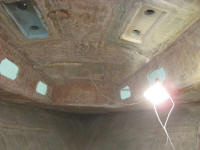 |
First, however, I sanded the entire inside of the
hull on both sides, from the cabin sole/centerline to the
top of the hull, and from the aft end of the cabin to the
tip of the chainlocker. In doing so, I removed all the
various left over bits of tabbing, rough edges, and
disgusting salmon-colored drunk tank paint that had been
applied to many areas of the hull long ago.
While this heavy session of grinding removed a lot of
material, I did not attempt to completely remove all the
paint in the weave of the woven roving, or to sand
everything perfectly smooth with these aggressive tools.
There would be more sanding later, to the extent necessary
and using less-aggressive tools, but for now the hull had
made great strides towards preparedness for future steps in
the project.
There were remnants of the old plywood
bulkheads and knees still stuck in some of the tabbing in
way of the old chainplates (the main chainplates), and since
I didn't have any prying-type tools on the boat at this time
to remove the wood bits, I left these areas unsanded for now
while I finished all the other areas. Tomorrow, I'd
remove the wood bits and grind down the remaining tabbing in
these areas. |
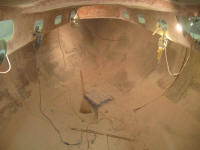 |
This all created a fair bit of dust, which filled
the recess where the head used to be to capacity when I
swept it all in that convenient receptacle, not including
the pile that formed on the shop floor below where I pushed
some of the dust out one of the old through hull holes.
Later, I scooped the dust out of the head and into a trash
can. |
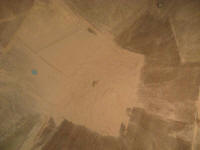
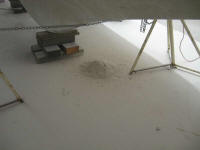 |
This was satisfying, if not particularly pleasant,
work, and it needed to be done. Getting back to the
pure essence of this boat's basic structure was the
necessary first step in her rebirth, and while the results
were exciting for me, I doubt that endless photos of
newly-sanded fiberglass will elicit the same response for
the faceless masses. That said, here is the end result
of the day's efforts. Nothing says "progress" to me
more than a clean hull and deck stripped of the detritus of
age, and this day saw good strides towards that end. |
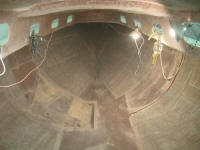
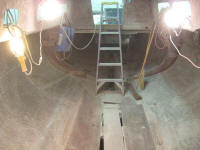
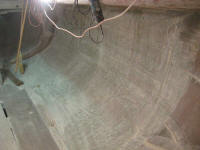
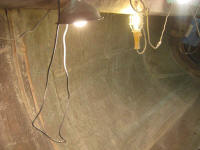 |
Total Time Today: 5.25 hours |
Previous |
Next |
|
|